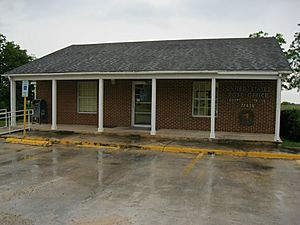Egypt, Wharton County, Texas facts for kids
Quick facts for kids
Egypt, Texas
|
|
|---|---|

Post office
|
|
| Country | United States |
| State | Texas |
| County | Wharton |
| Elevation | 131 ft (40 m) |
| Time zone | UTC-6 (Central (CST)) |
| • Summer (DST) | UTC-5 (CDT) |
| ZIP code |
77436
|
| Area code(s) | 979 |
| GNIS | 1335133 |
Egypt is a small, unincorporated community in northern Wharton County, Texas. An "unincorporated community" means it's a place with a shared identity but no official local government. In 2000, about 26 people lived there. Egypt is part of the larger Greater Houston area.
Contents
History of Egypt, Texas
Egypt was one of the very first places settled in Wharton County. It was even part of Colorado County during the time of the Republic of Texas, before Texas became a U.S. state.
Early Settlers and Naming
The land where Egypt sits belonged to John C. Clark. Other early settlers, Robert Kuykendall and Thomas Rabb, also owned land nearby. These three men were part of the "Old Three Hundred". This was the first group of families allowed to settle in Texas under Stephen F. Austin. The Karankawa Indians used to hunt along the Colorado River in this area. Thanks to these early settlers, the region became safe for more people to move in.
In 1829, Eli Mercer started a plantation and a ferry on the Colorado River. This was the beginning of the original community. The town grew where two important roads crossed: one from Matagorda to Columbus, and another from San Felipe to Texana.
The community got its name, Egypt, because of a big drought. During this dry period, Egypt was able to supply grain to nearby towns. This reminded people of the Bible story in the Genesis 42:1-3, where Egypt supplied grain during a famine. So, the name "Mercer's Crossing" changed to "Egypt" in 1827.
Growth and Development
In 1832, William J. E. Heard started the Egypt Plantation. He built his home in what is now the center of the community. His family continued to live there for many years.
A post office opened in November 1835, with Eli Mercer as the first postmaster. By 1840, four different mail routes passed through Egypt. The area was known for its rich soil, making it great for farming. Eli Mercer grew some of the first sugarcane in Texas. William Heard also ran a cotton gin in 1836, which processed cotton.
Texas Revolution and Important People
During the Texas Revolution, Captain Thomas Rabb gathered a group of soldiers from Egypt in February 1836. They joined the First Regiment of Texas Mounted Rifle Volunteers. These soldiers were part of the Texas army that fought in the Battle of San Jacinto, where Texas won its independence.
Many residents gathered in Egypt during the "Runaway Scrape". This was when Texans fled from the advancing Mexican army. They hoped the Texas army would stop the Mexicans from crossing the river.
Several important people lived in Egypt. These included William Menefee, who signed the Texas Declaration of Independence. Dr. John Sutherland, who carried messages for the Alamo, also lived there. Another famous resident was Gail Borden, Eli Mercer's son-in-law, who was a publisher and inventor. In May 1836, General Thomas J. Rusk and the Texas army even set up a temporary headquarters in Egypt.
Later Years and Modern Times
In 1839, Andrew Northington, Heard's son-in-law, ran a stagecoach line through Egypt. By 1840, a general store was very popular. It served as the voting place for the first election and continued to do so for many years.
In 1848, some clever people built a railroad track. It used horses to pull carriages, and the tracks were made of strong live oak wood. This early railroad connected Egypt to Columbus.
Before the American Civil War, Mentor Northington built a new cotton gin. His family operated it for over a century. In 1881, George H. Northington and Green C. Duncan started a large general store. This store was a central part of the community's business and social life. It sold everything from caskets and seeds to farm equipment, clothes, and groceries. The post office moved into this new store and stayed there until 1981.
From the 1930s until World War II, Egypt had a quarter horse racetrack. Many spectators from all over South Texas came to watch the races.
The Cane Belt Railroad was built through Egypt in 1901. It was sold to Santa Fe in 1902. However, the train service stopped in 1991, and the tracks were removed. In 1990, about 26 people lived in Egypt. The population remained around 26 in 2000.
On August 26, 2017, a tornado was spotted near Egypt.
Geography
Egypt is located on Farm to Market Road 102. It is about 11 miles (18 km) northwest of Wharton in Wharton County.
Education
Egypt had its own school district from 1854 to 1958. After that, it joined the Hungerford Independent School District. Today, students in Egypt attend schools in the El Campo Independent School District.
Notable person
- Joseph Kellman, a businessman and philanthropist, was from Egypt.
Images for kids




